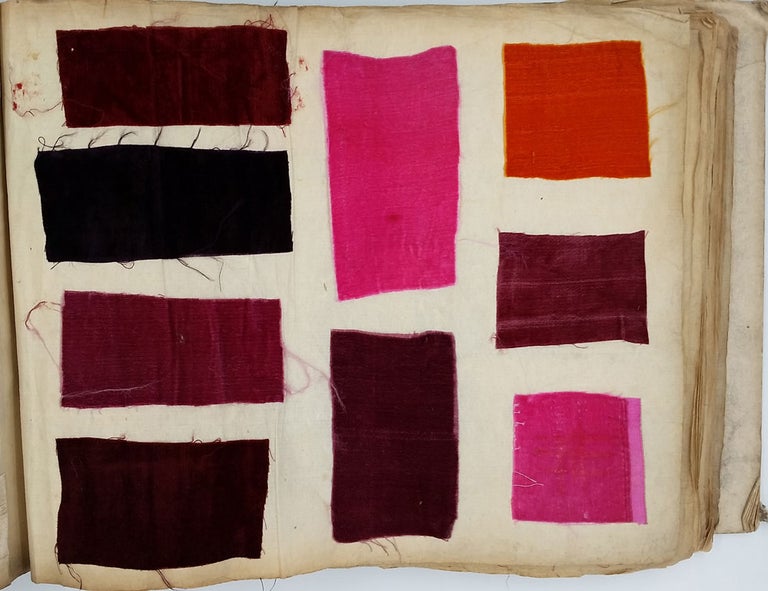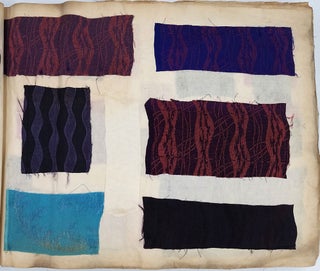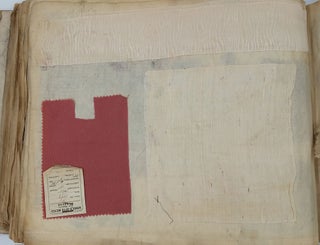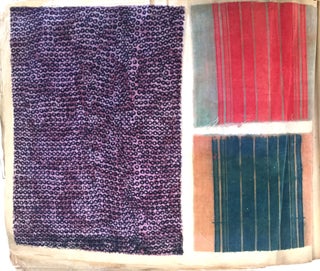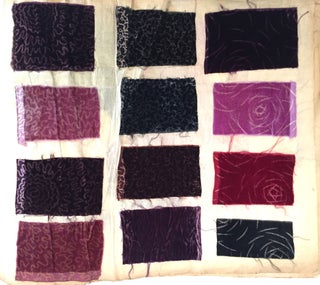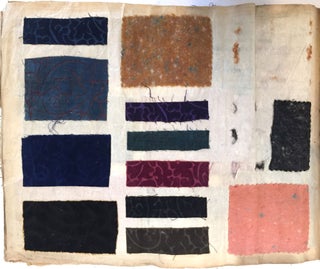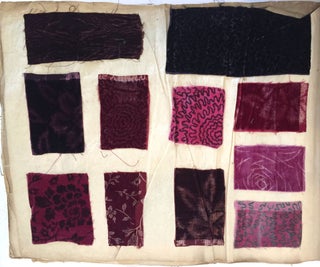Japanese Fabric Sample Portfolio with over 400 fabric swatches.
Kyoto, Japan: Ca. 1900. Hardcover. Meiji era sample fabric in-house catalog showcasing the remarkable new synthetic colors being introduced into Japan through trade with western nations. The catalog includes a broad range of deep purples, mauves and bright hot reds, fabrics colored with dyes of an intensity and durability previously not available in a country which used only animal and plant based dyes. The catalog offers a unique reference for Japanese fabrics as well as western fabrics in the Japanese market, demonstrating the growing influence of the foreign market in Japan at the beginning of the 20th century.
The catalog opens with large dark purple swatches followed by intense reds. Remarkably vibrant fabric swatches include silk, velvet, velour, brocade, crinoline, wool, cotton, and silk blend fabrics. These fabrics were used for kimonos, Western style clothing, lingerie, millinery, and drapes during the late Meiji period, from the late 1860s through the early 1900s. The catalog includes a broad range of styles and texture samples, not cut in uniform size but perhaps remnants from the cutting floor. A few of the samples have Western European trading house or manufacturers markings. This includes a sample with a printed label for Arnold Otto Meyer, a German trading house founded 1857 which actively imported much Japanese fabric until 1900. Another piece is a beautiful sheer silk sample marked 'Made in Switzerland. M. Ponget Japanese Trading Company', which actively sold to the Chinese market.
Purple and red were the most difficult colors to dye, and so became the colors associated with the noble classes in Japan. The new aniline dyes shown in these fabric swatches created a revolution in the fashion and textile worlds, and provided proof of the great profit to be made from the newest branch of science, organic chemistry.
William Perkin was the first to develop the aniline dye mauveine, which he derived from coal tar. Perkin's new synthetic purple was described by his teacher, the noted German chemist A. W. Hofmann in his essay 'On Mauve and Magenta', (Proceedings of the Royal Institution 3, (1858 - 62): pp468-83) as "a dye ‘of extraordinary tinctorial power". Throughout the 1860s Hofmann also worked in Germany on developing a range of synthetic colorful textile dyes, ultimately creating quinoline red in 1887.
The British developed & patented the new synthetic dyes, but did not have the money for production; the Germans filled the void and grew to dominate the chemical dye industry. In this catalog there is a sample of a German imported fabric with printed German manufacturer's label of Arnold Otto Meyer, a German trading house which traded extensively with Japan.
In Japan, the textile and chemical industries were two of the first to modernize. By 1870 the Japanese Chemistry Bureau was founded and German and British chemists were invited to establish the first chemistry department at Tokyo University. In the early 1870s Japanese dyers went to Osaka to learn from the English experts in dyeing; others went to France and Germany. In 1875 the Somedono, or Dyeing Palace was established in Kyoto to teach the use of synthetic dyes, and by the next year Japanese dyers had incorporated synthetic colors into their trade. Dyes were imported from English, Swiss, French and German sources, with the greatest proportion from England.
Oblong folio (16 1/4 x 12"), unnumbered [100] pp. 414 woven and embroidered fabric samples are tipped in, on rice paper pages. Sizes range from 1 x 2" up to 11 x 14". Contemporary gray paper covered boards, some scuffing and wear at corners. Japanese punch sewn with cord binding and tassel. Some samples with minor fraying to foredges, some peeling up from the adhesive at corners, occasional marking from glue. Very good overall. Item #22639
Price: $950.00


